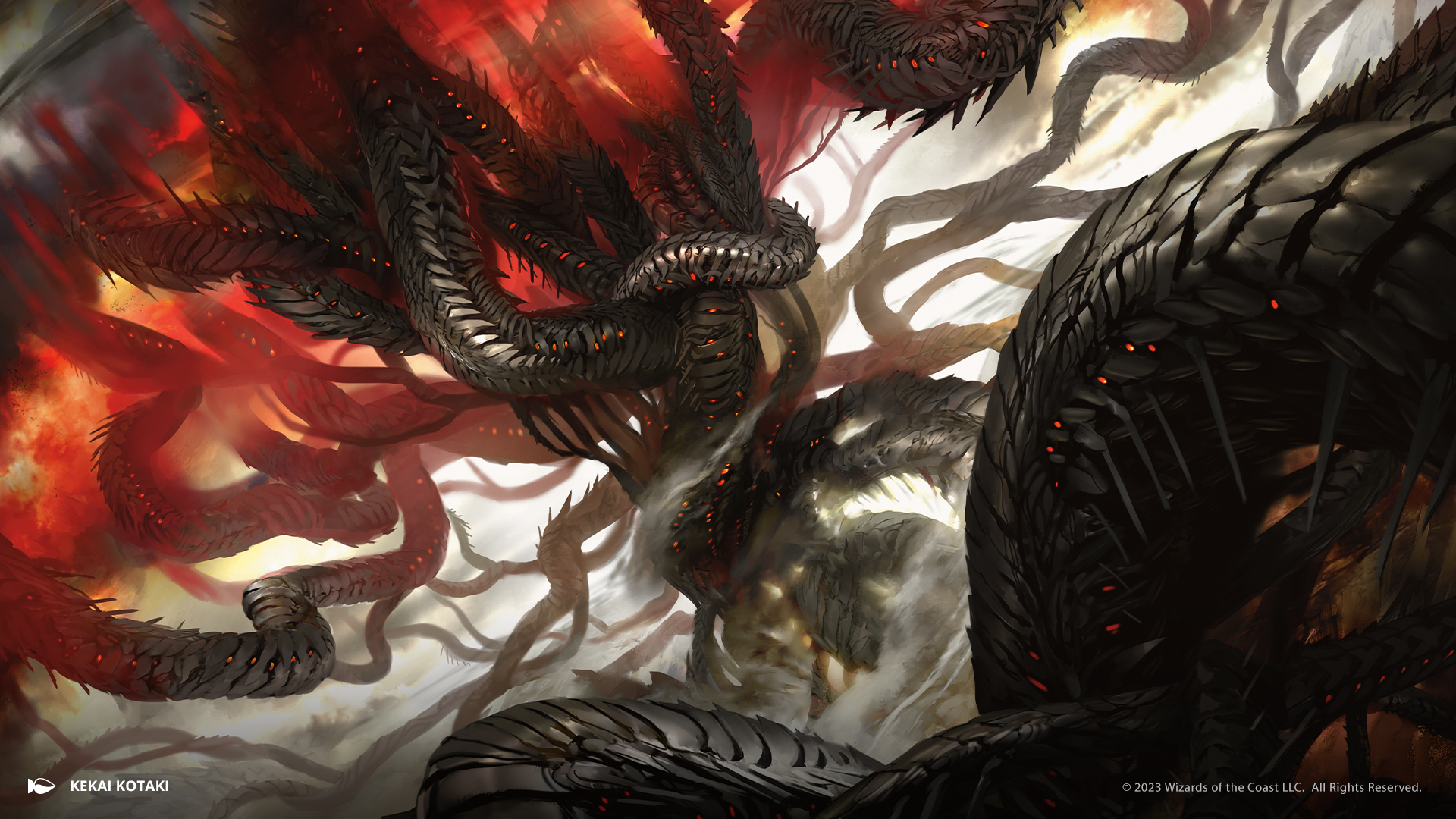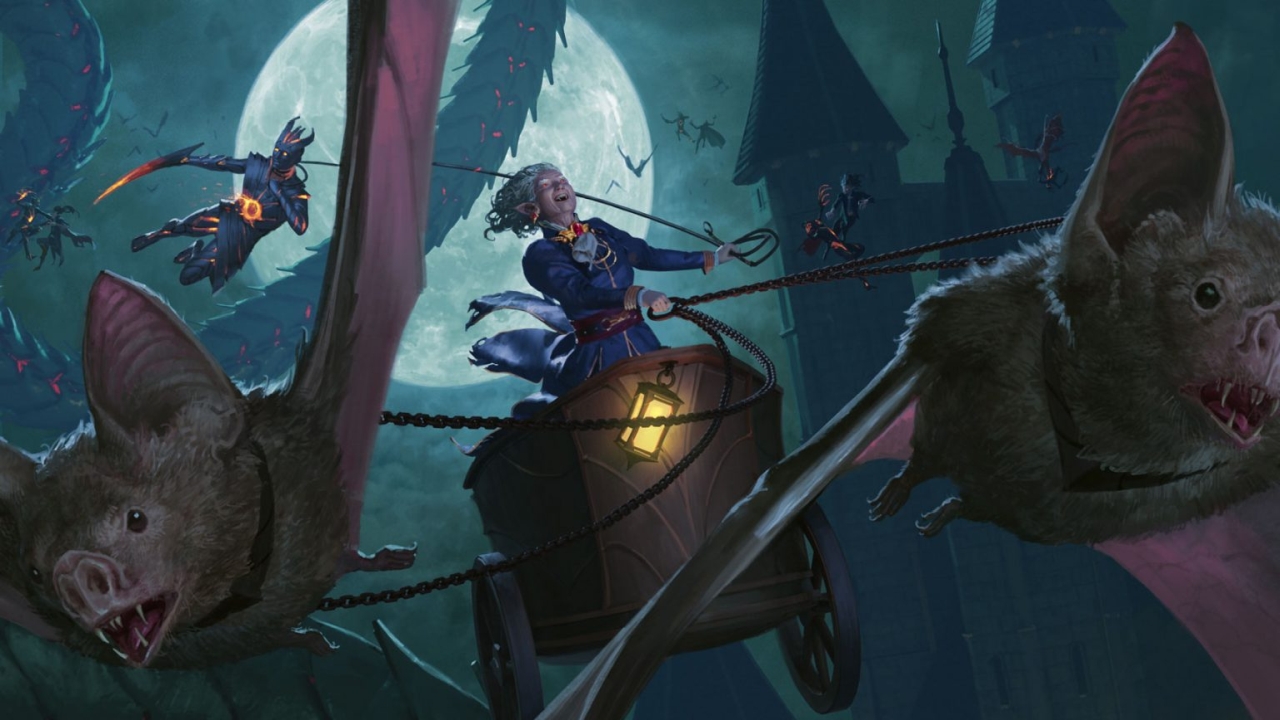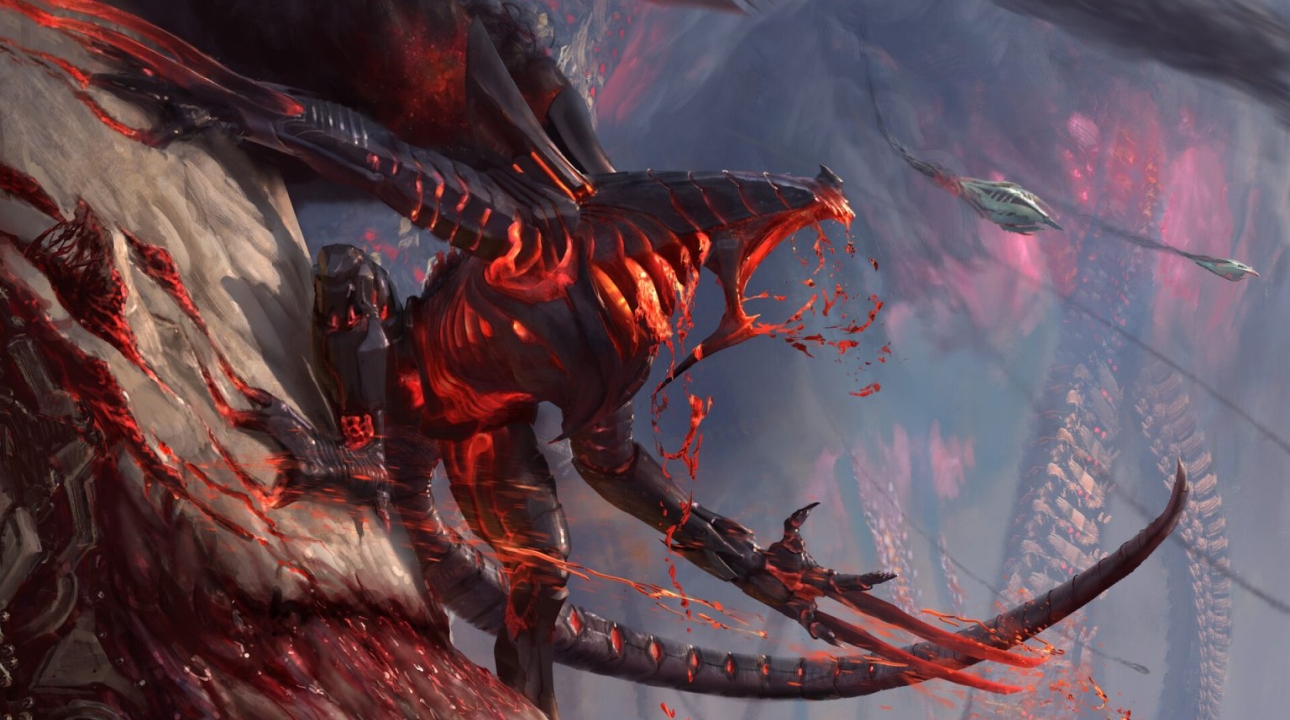March of the Machine, Magic's latest set, is great for some formats but not others
The new Magic: The Gathering cards are a perfect illustration of why there are so many different ways to play Magic now.

I got killed by a tree. To be fair, it wasn't any old tree—it was Realmbreaker, a gigantic supernatural shrubbery the metallic Phyrexians are using to invade the multiverse in Magic's March of the Machine set. Still, it was a surprising way to go.
Every time the player who cast Realmbreaker, the Invasion Tree activates it, their opponent has to take three cards off the top of their deck and add them to the discard pile. If one of the cards they throw away is a land, the cheeky bugger who played Realmbreaker gets to keep it.
My opponent had pinched four Islands off me so far, which was annoying, but I still thought I had it in the bag. I was winning on the battlefield, with a couple of flying creatures sailing over his ground-based force to ding him for a few life every turn while I was sitting pretty on 19 points. He'd done the math, however, and I hadn't.
In Magic, forcing a player to discard from their deck is called milling, because the first card to let you do that was called Millstone. The danger is that you'll run out of cards, resulting in an automatic loss next time you go to draw and come up empty. I've gotten used to playing formats like Commander, with its gloriously unwieldy 100-card decks, and Standard with the traditional 60. In those, milling someone to death takes too long unless you've built an entire deck around the gimmick. On this particular night I happened to be playing a format with 40-card decks, and while I was chipping away at his health he'd been chipping away at my cards.
By the time I realized what was happening, I was three turns away from losing and it was too late to do anything about it. I got him down to his last five life points, then shook his hand.
As Magic's grown in popularity so have the number of ways you can play it. If buying a bunch of booster packs and building a 60-card deck to face off against someone who's done the same isn't your thing, there are plenty of other (just quietly, better) ways to play. Some Magic sets are designed with specific formats in mind, like last year's Commander Legends: Battle for Baldur's Gate, which was made for the chaotic table-full-of-players Commander format. Jumpstart 2022 was all about Jumpstart, a format where you take two themed sets of 20 cards and smush them together, a streamlined way to try out a manageable number of new cards, and the one I was playing when I got killed by a tree.

March of the Machine isn't for a specific format, being a climactic, end-of-arc narrative set, one that finishes a story that's been told over multiple previous sets. That doesn't mean it's equally fun in every format, though. It's heavy on bombs, the kind of powerful cards that represent the heroes and gods engaged in this epic conflict and the powers they wield. In a limited format like Booster Draft, where everyone builds decks together by passing around packs and taking one card at a time, bomb-heavy sets are less fun.
Keep up to date with the most important stories and the best deals, as picked by the PC Gamer team.
If you crack open a booster and see a bomb like Chandra, Hope's Beacon (a planeswalker who lets you cast a second copy of one instant or sorcery spell every turn for free), or Glissa, Herald of Predation (who can give every Phyrexian creature you control deathtouch and first strike each turn), you're obliged to build your deck around them rather than having the freedom to choose other options. If you don't, or if you get unlucky and don't score any bombs while other players in your group do, you'll probably lose immediately when you come up against them.

March of the Machine comes into its own in other formats. The new battle cards, for instance, shine in Commander. These are cards you place in an opponent's battlefield and then have the option to attack instead of going for the player, chipping away at the battle's defense counters until they're depleted, at which point you get to flip it over and cast the spell on its reverse for free.
Normally games of Commander start slow, with three or four or however-many players who don't want to be the first to attack someone and seem like a big meanie the other players should gang up on. Battles give you something to do in those cautious early turns without making a target of yourself. Then, when you flip them, whatever reward you've just earned is probably something you can go on a proper offensive with, moving the match into its more aggressive phase.
Plus, having multiple opponents means you can choose to set up your battles where they'll be easiest to attack, picking the player least able to protect them. Though players can prevent you winning battles with more than just a horde of creatures—it took me too long to realize the proliferate mechanic, which adds extra counters and was recently brought back in Phyrexia: All Will Be One, affects the defense counters on battles too. We'll see even more interesting interactions with battles as players experiment with them.

March of the Machine feels like a solid addition to Standard as well. If you're sick of all the mono-red decks bringing Phoenix Chicks back from the dead over and over, Seal from Existence lets you exile them instead, making it harder to return them to play. Meanwhile Atraxa's Fall destroys any artifact, enchantment, battle, or creature with flying, a response to any number of annoyances. It's not all about negating though, and those bombs will change the state of play for sure. As someone still running a deck with Invoke Despair in it—a card that makes people ragequit matches in Arena already—the idea of using Chandra, Hope's Beacon to copy each one I cast for free has me practically drooling.
I won't go through how March of the Machine will impact every format because we'd be here all day (though I note that Ragavan, the Pilferer, the monkey so strong they told him he couldn't play, is legal in Historic Brawl if you really want to ruin someone's day). And anyway, there are too many formats for any one person to keep up with. The same night I was being killed by a tree, one of the judges told me about how much fun he'd had playing Two-Headed Giant, a popular format for two teams of two, and I just smiled and nodded because I still haven't tried it.
This proliferation of formats is undoubtedly a good thing. There are reportedly 40 million people playing Magic as of 2021, and they don't all want to play the same way. A deck of ordinary cards can be used to play games as different as gin rummy, bridge, and solitaire, and a collection of Magic cards can be almost as diverse. It means that not every new set will be for every player, but that's a good thing too. Because honestly, who could afford them if they were?

Jody's first computer was a Commodore 64, so he remembers having to use a code wheel to play Pool of Radiance. A former music journalist who interviewed everyone from Giorgio Moroder to Trent Reznor, Jody also co-hosted Australia's first radio show about videogames, Zed Games. He's written for Rock Paper Shotgun, The Big Issue, GamesRadar, Zam, Glixel, Five Out of Ten Magazine, and Playboy.com, whose cheques with the bunny logo made for fun conversations at the bank. Jody's first article for PC Gamer was about the audio of Alien Isolation, published in 2015, and since then he's written about why Silent Hill belongs on PC, why Recettear: An Item Shop's Tale is the best fantasy shopkeeper tycoon game, and how weird Lost Ark can get. Jody edited PC Gamer Indie from 2017 to 2018, and he eventually lived up to his promise to play every Warhammer videogame.

